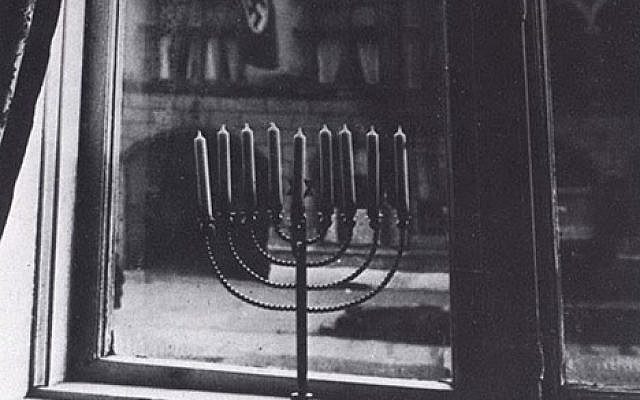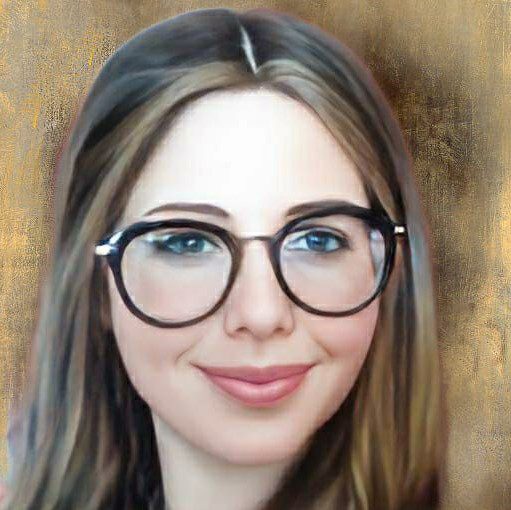Menorah Everlasting

The photograph is haunting—a juxtaposition of life and death, revival and destruction. A menorah, symbol of the indomitable spirit of the Jewish People, stands proudly in the front window of a Jewish home in Germany. Directly across the street lurks the ominous shadow of a Nazi SS flag, draped before the imposing German Parliament building.
Who owned this menorah and under what circumstances was it lit? Who was the intrepid photographer, and what was his or her fate? Moreover, what was the destiny of the menorah itself? Did it survive the mocking glare of the deaths’ head insignia threatening it from across the front lawn?
The story is as fascinating and inspiring as the picture that encapsulates it. A prescient woman and her courageous husband. An entire congregation saved from the ghoulish clutches of the Holocaust. And a menorah that continues to shine its eternal message, generations later, now ensconced in its rightful abode, Eretz Yisrael.
“The photograph was taken by my grandmother in 1931, when the Nazi party had been instated in Parliament but hadn’t yet risen to power,” begins Yehuda Mansbach, of Beit Shemesh. Despite being invited to share his amazing story many times with media outlets, schools, and at other gatherings, his voice is still colored with fresh enthusiasm. “My grandmother took the picture because she recognized the irony in the scene, that here they were, celebrating Chanukah, with the pall of death hanging over their heads from just a few feet away.”
Yehuda’s grandfather, Rabbi Akiva Posner, served as the rav of Kiel, a port city in Germany, and the family lived right across the street from the German Parliament building.
What is perhaps less well-known about the photograph is the epic inscription penned on the back of it by its photographer, Yehuda’s grandmother, Mrs. Rachel Posner. Drawing on her extensive knowledge of Tanach and classic German literature, she wrote the following lines, including a passage from the words of Yoel Ha’Navi:
“Yehuda tei’hareis,” kach choshev ha’degel. (“Yehuda will be destroyed.” So thinks the flag.)
“Yehuda le’olam teisheiv,” kach omer loh ha’ner. (“Yehuda will remain forever!” So the candle tells the flag.)
The implication is obvious: Despite the ghastly sworn mission of the Nazis, the menorah laughs in its face, shouting, “Am Yisrael Chai!”
She was 31 at the time, mother to three young children ages 4, 6, and 8, but with a piercing clarity, Rachel Posner knew that the world as they knew it was fast unraveling and she captured that sentiment in the powerful picture that eventually found its way to the Yad Vashem museum in Jerusalem many years later.
Her husband, Rabbi Akiva Posner, was no less prophetic. In an era which, sadly, is notorious for widespread denial of the true intentions of the Nazi beast, he saw the writing on the wall nearly two years before the Nazis rose to power. A highly educated rabbi and scholar, he boasted a massive library of 5,000 books, many of them rare manuscripts, and clergymen of other faiths often came to attend the Shabbos morning sermons of the esteemed Doktor Rabbiner. Rabbi Posner faithfully stood at the helm of Kiel’s small Jewish community which numbered 500 Jews from across the religious spectrum.
But Germany was changing and the Posners were under no illusions about what lay in wait. They watched as the Nazi party took over completely. They watched as propaganda filled the streets and the radio waves. And finally, they watched as the noose began to tighten around their kehilla as the first of the anti-Semitic laws were gradually introduced in 1933.
On April 1, 1933, the edict was issued: it was forbidden to enter Jewish stores. That Friday night, Rabbi Posner departed from the usual Ashkenazic custom and asked that Mizmor Le’David be recited three times. “Hashem ro’i loh yechsar,” he chanted aloud. Then he announced that tomorrow’s Shacharis minyan would be held earlier. “We need to finish davening before the police come to bother us,” he added. Sure enough, the following morning, the Gestapo stormed the synagogue. The next of the Nazi laws had just been passed; synagogues were to be shut down.
That Shabbos morning, Kiel was rocked by its first example of raw Nazi brutality. The son of a non- Sabbath-observant shopkeeper came to visit his father at the family store, but his entrance was blocked by German police. After all, it was forbidden to patronize Jewish establishments. The son argued with the police and was promptly arrested. That afternoon, the news spread like wildfire: the shopkeeper’s son had been shot in cold blood and his body was being held at the local prison.
Rabbi Posner did not waste a moment. He quickly made his way to Gestapo headquarters and requested, as the Rav of the city, permission to give the boy a proper Jewish burial. The Nazis finally agreed, stipulating that the burial had to take place a minimum of 40 miles from Kiel city limits and with no observers in attendance. It took three days for the body to be released and Rabbi Posner traveled to a nearby city to conduct the levaya.
“When he left Kiel to do the levaya, my grandmother was sure she would never see him again,” Yehuda says. “She thought it was the end.”
But it was not the end. In fact, it was the very beginning. Rabbi Posner’s convictions were stronger than ever now and there was no turning back. The roshei ha’kehilla also realized that their Rav was in great danger and they insisted that he leave Germany. So Rabbi Akiva and his wife Rachel immediately packed their bags and took advantage of the narrow window where escape was still permitted. The entire community accompanied the Posners to the train station where the rabbi gave his last sermon.
“He urged the entire community to run for their lives, however they possibly could, and at the same time he also emphasized the importance of them remaining unified. Then the family departed for Belgium,” says Yehuda Mansbach.
That was Rabbi Akiva Posner’s final act as a communal rabbi. He never agreed to take up the mantel of leadership again.
Life was difficult for the Posners in Belgium, but when relatives in the United States urged them to emigrate to North America, the rabbi refused, saying he would not “trade one galus for another galus”. Instead, he contacted his siblings who already lived in Yerushalayim, for help. They approached Rav Kook, z”l, the Chief Rabbi of Israel at the time, who used his diplomatic status to procure rare entrance visas for the Posner family from the British mandate. In 1934, the Posners landed in Eretz Yisrael, the photograph and the menorah safely tucked in their luggage. Amazingly enough, Rabbi Posner managed to bring his entire extensive library along with him, shipping 5,000 books overseas. He later donated them to the famous library at Heichal Shlomo where he eventually served as chief librarian.
The famous menorah was lit in the Posner home for the next thirty years until the Rav was given a gift of a silver menorah. Two years later, Rabbi Akiva Posner passed away. He had lived to see his children and grandchildren flourish in the Land of Israel—today he has 90 descendants, Baruch Hashem, all who live in Eretz Yisrael. But what’s more, he had been instrumental in saving the lives of countless of his own brethren; of the 500 Jews originally living in Kiel, only 9 remained when the Nazis came to take them away to the extermination camps. The Jews of Kiel had heeded the call—and the personal example—of their rabbi and fled to freedom.
“Many of them ended up in Israel and my grandfather was later invited to officiate at the weddings of their children,” recalls Yehuda Mansbach. “They kept in close touch with him and they always asked him to be their Rav again, but he always refused. He always said that he had had one kehillah, which he left behind in Germany, and that was it.”
The strength and courage that the Posners embodied in Germany was their hallmark in Eretz Yisrael as well and they stood by their convictions and faith at every turn in the road.
The photograph’s powerful message would be invoked again, under very different circumstances, when Rachel Posner’s son went to the yishuv of Yamit to protest the forced disengagement of this Jewish community from the Gaza Strip in 1982. He returned, heart-broken at the sights he had witnessed as Jews were forcibly torn from their homes—by their fellow Jews, and shared his sorrow with his mother.
The family matriarch was undaunted.
“Am Yisrael Chai,” she said, pointing to her prize photograph. “No one can destroy us.”
Not the Nazis, not the Greeks, and, le’havdil, not even our own brethren, can break the spirit and endurance of the Jewish People.
In the 1990’s, Rachel Posner’s poignant picture was sold by the German government to Yad Vashem. She had submitted it to a German-Jewish newspaper in the 1930’s, a short while after snapping it, and when Yad Vashem was soliciting paraphernalia for its museum, the German government, infamous for its meticulous archives, was only too happy to make a few dollars by selling the photo. It hung in the
Museum for several years on a window in a special exhibit showing a typical Jewish home in pre-war Germany.
After many years of the photograph being displayed at Yad Vashem, the startling discovery was made that the actual, original menorah featured in the striking, black-and-white picture was still in existence—and located in Haifa, Israel, no less!
Rachel Posner had already departed This World when Yad Vashem contacted her grandchildren with a request to borrow the treasured artifact for their exhibit, but the offer was politely declined.
“My son Akiva is named for his great-grandfather and the menorah was given to him to light,” explains Yehuda Mansbach. “We obviously have a special connection to it and we couldn’t give it up.”
An arrangement was reached whereby the museum was given permission to display the menorah year ‘round. But every Erev Chanukah, Yehuda drives down to Yad Vashem to pick up the precious menorah and bring it home for his son to light. “I return it some time before Asarah b’Teves,” he adds, with a patient smile.
The fact that the entire Posner family, including their extended family, was saved from the throes of the Holocaust, is no small miracle. Yehuda recalls that as a young boy in Gan, he was the only one in his class to have two living grandparents, something virtually inconceivable to the post-war generation. Interesting, as well, is the fact that although they generously share their special menorah with Yad Vashem, the family has no personal connection to the Memorial Museum, being that all of their relatives were spared.
Did Rav Posner ever feel remorseful, that he had abandoned his congregation, having been the first to leave?
“I asked my mother about that, actually,” says Yehuda. “She said that no, he had no qualms about leaving because he did so hoping to pave the way for the rest of the community. And, indeed, that’s what happened. In essence, he told them, ‘I’m leaving and I want everyone else to follow!’”
Today, when young Akiva Mansbach lights his great-grandfather Rabbi Akiva Posner’s menorah in the window of his father’s Beit Shemesh home, the Nazi flag that once snubbed it from across the street has been long relegated to the darkest annals of History.
Today, those dancing flames passionately proclaim Rachel Posner’s timeless inscription.
“Yehuda tei’hareis,” kach choshev ha’degel.
“Yehuda le’olam teisheiv,” kach omer loh ha’ner.
This article originally appeared in Ami Magazine, www.ami-magazine.org.

